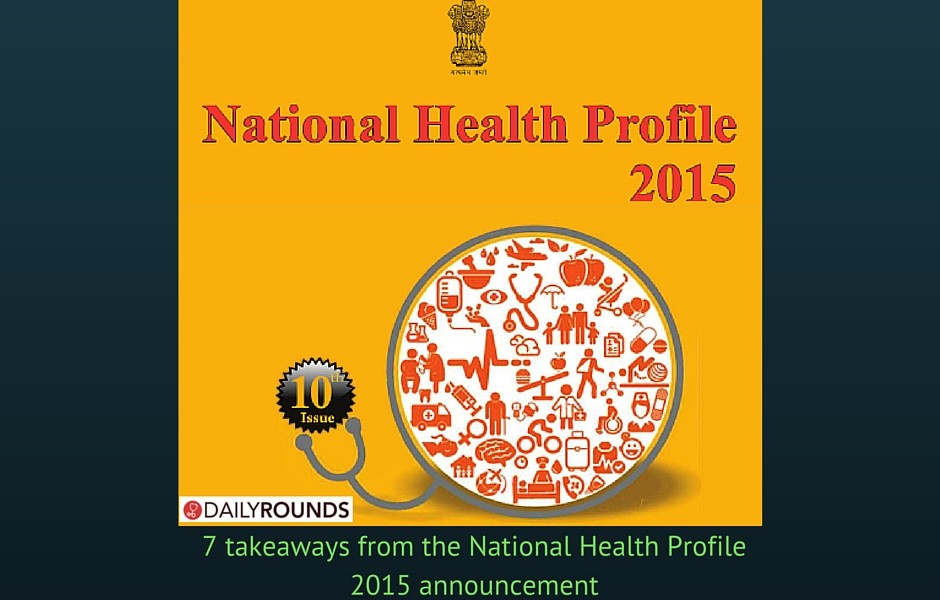
7 takeaways from the National Health Profile 2015 announcement
Union Minister for Health J.P. Nadda released the National Health Profile 2015 prepared by the Central Bureau for Health Intelligence (CBHI) on Tuesday along with officials of the Ministry, the Directorate General of Health Services and the CBHI. Here are the 7 key takeaways from the report-
1. Alleopathy, AYUSH and Nurses
India has a total of 9,38,861 allopathic doctors, 7,36,538 Ayush (ayurvedic, yunani, siddhi and homeopathy) doctors and 25,66,067 nurses.
2. Dentistry and Pharmacy
India also has 1,54,436 dental surgeons registered upto 2014 and 6,64,176 pharmacists as on June last year.
3. Rural Sector
In the rural sector there are 27,355 registered doctors out of which 4,091 were specialists.
4. Healthcare assistants & workers
There were 10,358 male health assistants and 13,643 female health assistants, while the number of multipurpose health workers was 55,445 (male) and 2,17,780 (female).
5. Rural PHCs
As far as rural areas were concerned, Andhra Pradesh had the highest number of doctors at the Public Health Centres (3,118). The capital Delhi had only 20 doctors available at PHCs.
6. Medical education infrastructure
Medical education infrastructure has shown rapid growth during the last 20 years, with the country having 398 medical colleges, 305 dental colleges (bachelor degree level) and 224 dental colleges (masters degree level).India has 2,865 institutions producing 115,484 general nurse midwives annually and 723 colleges for pharmacy with an intake capacity of 43,300 as on December 2014.
7. Hospitals & Beds
There are 20,306 hospitals having 675,779 beds in the country, 16,816 out of these are in rural areas and and 3,490 hospitals are in urban areas.
Additional Information
Registered Doctors
Maharashtra had the highest number of registered doctors at 148,575 closely followed by Tamil Nadu at 102,328 while Arunachal Pradesh had the least at 510. The report by the Central Bureau of Health Intelligence (CBHI) said that there has been an increase in the availability of allopathic medical practitioners, dental surgeons and nurses per lakh population over the years.
Communicable Diseases
Deaths from most communicable diseases have been falling steadily in India. Despite recording over 10 lakh cases, deaths from malaria are officially down to just over 500 annually; Odisha accounted for over one in three cases of malaria in 2014. The number of recorded chikungunya cases has fallen since a 2010 outbreak, but Maharashtra accounts for nearly half of all cases. Just over 40,000 cases of dengue were officially reported in 2014 and 131 deaths. While the number of cases of Acute Diarrhoeal Disease has risen every year to 1.16 crore in 2014, mortality from the disease has been steadily declining.
However, 2014 saw a sharp spike in cases and deaths due to Acute Encephalitis Syndrome, a disease concentrated in Uttar Pradesh, Bihar, Assam, and West Bengal. Japanese Encephalitis, concentrated in Assam and Uttar Pradesh also rose last year. Pulmonary tuberculosis remains the biggest communicable disease killer in India, accounting for over 63,000 deaths in 2014. Since disease data is largely reported from government health facilities only, it is likely to be heavily underestimated, CBHI officials said. Non-communicable diseases are on the rise with cardiovascular diseases according for a quarter of deaths from non-communicable diseases and cancer accounting for six per cent.
Here is the complete report as an e-book: National Health Profile 2015
Enjoyed reading this news story? For MORE medical discussions,image cases, MCQs and medical news download the DAILY ROUNDS app for FREE! at App Store or Play Store
Original Post: Business Standard, The Hindu
Image Credit: Central Bureau for Health Intelligence (CBHI) – National Health Profile 2015